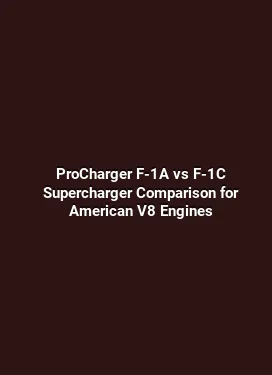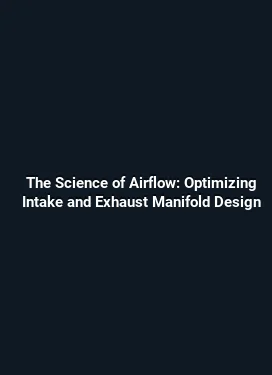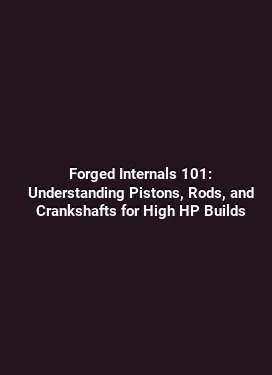BorgWarner EFR 7163 Turbo Build Guide for Mitsubishi Evo 8-9
EFR 7163: Core features and why it suits the Evo 8-9

The BorgWarner EFR 7163 represents a compact, high-precision turbocharger designed to deliver a balanced blend of fast spool, strong top-end flow, and reliable operation under demanding conditions. Its billet compressor wheel and efficient turbine housing options are crafted to reduce lag while maintaining robust air delivery across a broad RPM range. For the Mitsubishi Evo 8-9 platform, this combination translates into a responsive daily driver with solid midrange torque and a flat, controllable boost curve that supports both street use and track sessions. The compact footprint helps with engine bay packaging, allowing easier routing of charge pipes, intercooler piping, and oil lines compared to larger, higher-capacity units. This makes the 7163 a popular choice for enthusiasts pursuing substantial power gains without sacrificing throttle response. The Evo 8-9 benefits from an efficient intercooling path and a relatively forgiving exhaust flow, both of which pair well with the EFR 7163. The turbo’s design encourages clean turbine matching to the Evo’s intake and exhaust geometry, reducing surge risk and helping the turbo reach target boost more predictably. While the platform’s stock engine and supporting components set practical limits, a properly engineered 7163 build can deliver meaningful gains in horsepower and torque while maintaining driveability and reliability when tuned with care and attention to cooling, lubrication, and fuel delivery.
Key design elements that affect performance

Several design features in the EFR 7163 drive its performance characteristics in the Evo 8-9. A billet compressor wheel contributes to higher efficiency and a more stable flow across the compressor map, which in turn improves throttle response and reduces compressor surge risk at higher boost levels. The bearing system, typically a high-strength, durability-focused arrangement, lowers rotational losses and supports quicker spool while sustaining reliability under sustained boost. An integrated or well-matched wastegate option helps control boost with a refined, predictable curve rather than relying on slow or unstable boost rise. The turbine housing choices allow tailoring of exhaust flow to the Evo’s exhaust manifold and downpipe routing, which is crucial for minimizing backpressure and preserving low-end response. A well-chosen EFR 7163 configuration also benefits from modern materials and manufacturing tolerances that resist heat soak and maintain consistent performance across multiple track sessions or warmer ambient conditions. In the Evo 8-9, this translates into a turbo that spools quicker than larger units while still delivering solid airflow at peak RPM, provided the rest of the drivetrain and fueling are prepared to sustain the resulting power level. Practitioners often pair the 7163 with a carefully engineered intake path and a well-matched intercooler to maximize charge-air density without incurring excessive pressure drop, which supports both performance and reliability in everyday driving scenarios.
Matching the EFR 7163 to Evo 8-9: fueling, turbo plumbing, intercooler, exhaust
Integration starts with fueling and air-handling systems. Upgrading the fuel system is essential when moving beyond stock boost levels. A higher-capacity low-pressure pump on the main rail, plus appropriately sized injectors to maintain a safe air-fuel ratio during full-throttle operation, are critical. For gasoline engines, tuning around a safe target air-fuel ratio at peak torque is essential to minimize detonation risk and protect the engine internals. In practice, this means selecting injectors that can deliver enough fuel across the expected load range and using a reputable, high-quality fuel-pressure regulator or return-style setup. Wideband feedback is highly recommended to verify the actual AFR during surge-free boost transitions and to guide the calibration process with real-time data. Turbo plumbing involves a clean, direct path from the exhaust manifold to the EFR 7163 and onward to the intercooler and intake charge air. A piping diameter in the 2.5 to 3 inch range is common, with smooth bends to reduce turbulence and pressure drop. The intercooler choice should balance core size, pressure drop, and heat rejection; a well-matched core prevents parasitic heat soak during hard runs and maintains charge temperature throughout a session. The downpipe and exhaust route must be optimized for scavenge flow, with attention paid to flange quality, gaskets, and secure mounting to avoid boost- or leak-induced fluctuations.
Fuel system upgrades and injector sizing
Injector sizing is one of the most critical decisions in a turbo upgrade. On the Evo 8-9, selecting injectors that can deliver appropriate fuel across the RPM range while supporting the intended boost target is essential. A common approach is to choose injector flow rates that enable a safe stoichiometric or slightly rich mixture at high load, depending on fuel type and octane. If ethanol blends are part of the plan, account for the increased oxygen content and cooling effects by adjusting the injector size and tuning strategy accordingly. It is also prudent to install a robust fuel pressure regulator and to verify rail pressure stability during ramp-up and sustained boost. The ECU calibration should incorporate wideband feedback, a fuel trim table, and a nuisance-free diagnostic plan to detect deviations early during the tuning process.
Boost strategy and control
Boost strategy centers on delivering a predictable, linear rise in boost that matches the Evo 8-9’s mechanical response and the engine’s fueling capability. An internal or external wastegate can be selected based on the desired control philosophy and space constraints in the engine bay. For many builds, a hybrid approach that uses an electronic boost-control loop combined with a wastegate provides the most reliable behavior: boost ramps smoothly with throttle input, then stabilizes at the target level during part- and full-throttle operation. The goal is to avoid rapid boost spikes or delayed ramping, which can challenge fuel timing and knock control. A well-tuned boost strategy also considers heat management, since higher boost levels generate additional heat that can affect air density and sensor readings during extended sessions.
MAP-based boost control and direct monitoring of manifold pressure can help you tune a linear and repeatable boost curve. The Evo 8-9’s OEM sensors can be leveraged in a carefully calibrated map for data-driven control, while a quality boost-vs-LO tension approach reduces the risk of unintended boost fluctuations during gear changes or aggressive maneuvers. Remember to align the boost strategy with the cooling and fueling plan so the engine does not experience knock, especially on hot days or during track sessions when heat load is elevated.
Boost curves and MAP sensor calibration
Calibrating the MAP sensor involves matching the sensor output to the expected pressure range across the entire RPM and load spectrum. A well-documented boost curve is essential for repeatable performance and safe operation. Start with a conservative baseline curve, then gradually increase boost while monitoring AFR, knock, track temperature, and oil pressure. The aim is a smooth, progressive rise that reaches target boost without overshoot, followed by a plateau that maintains stability under high-load conditions. Logging should include manifold pressure, intake air temperature, fuel pressure, accelerator pedal position, and timing corrections to identify any interdependencies or unexpected behavior during the tune.
Installation and fabrication considerations
Physical fitment is not just about walls and space; it also involves material compatibility, routing paths, and sensor positioning. Before installation, survey the Evo 8-9’s engine bay to identify the tightest clearance areas around the exhaust manifold, radiator, and intake ducting. The 7163’s compressor housing and outlet should align with the charge pipes to minimize bending radii and reduce pressure drop. Secure mounting points, heat shielding, and vibration isolation help preserve seal integrity and sensor accuracy. It is also important to verify clearances when the car is lowered or equipped with aftermarket parts that can change under-hood geometry. A clean, well-supported plumbing layout reduces the likelihood of hose collapse, sensor interference, or exhaust leaks during high-RPM operation.
From a reliability perspective, the oil feed and return lines must be correctly sized and routed to prevent starvation during high-load events. Heat management remains critical; using a suitable intercooler heat exchanger and ensuring adequate airflow across the radiator helps maintain stable intake temperatures, especially in competition or hot-weather scenarios. Wiring looms should be secured away from hot surfaces and moving parts, and all connectors should be moisture-protected and vibration-tolerant for long-term durability. Proper gasket selection and torque sequences play a key role in avoiding leaks at the turbocharger, downpipe, and flange interfaces.
Intake, exhaust, and plumbing routing
Paths for intake and charge-air piping should minimize bends, with smooth transitions between components to maintain laminar flow. The compressor outlet to intercooler should have a direct route, and the intercooler outlet to the intake manifold should avoid long, restrictive runs. For the exhaust side, ensuring a gradual exhaust flow from the turbine to the downpipe reduces backpressure that can otherwise hamper transient response. When routing return lines and breather plumbing, choose alloy or high-grade steel lines where appropriate and secure lines to avoid chafing or heat exposure. A careful routing strategy also reduces the risk of vacuum leaks that could negatively affect boost control and fuel trims during tuning sessions.
Tuning and reliability: common pitfalls and best practices
One of the most common pitfalls is underestimating the importance of a solid baseline tune. Begin with a conservative map, validate ignition timing, and verify that the fuel system maintains a safe air-fuel ratio across all RPM bands. Use data logging extensively during the initial tuning phase to catch knock, fuel pressure dips, or pressure leaks early. It is better to advance boost gradually and verify the engine’s response than to push for peak power immediately. Proactive monitoring of engine temperature, oil temperature, and oil pressure provides early warnings of potential reliability concerns that could compromise long-term performance.
Reliability also hinges on oiling and cooling. Ensure the turbo receives clean, adequate lubrication with a recommended oil grade and viscosity for high-boost operation. Regular oil changes with quality oil help protect the bearings, seals, and passages under sustained boost, especially in hot track environments. Cooling upgrades, such as a larger intercooler core or upgraded radiator fans, help maintain consistent intake densities and prevent heat soak that could degrade performance or trigger knock. A disciplined maintenance plan—including periodic inspections of hoses, clamps, gaskets, and sensor connections—extends the life of the turbo and the entire forced-induction system.
Wheel-speed, compressor surge prevention, and cooling strategies
Compressor surge is minimized by proper compressor map matching and by ensuring a stable boost boundary across the engine’s operating range. If surge is observed at boost onset, revisiting the intake routing, turbine housing selection, or intercooler size can help. Cooling strategies extend turbo life and maintain performance; consider additional intercooling capacity or more efficient heat rejection in high-temperature environments. Keeping air intake temperatures in check helps preserve air density and reduces the likelihood of knock. In practice, this means choosing a well-matched intercooler and maintaining clean, consistent airflow through the front-mounted radiator and cooling ducts while avoiding sharp bends or restrictive couplings in charge-air piping.






